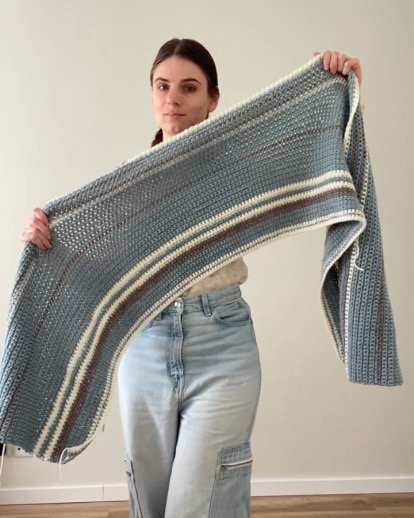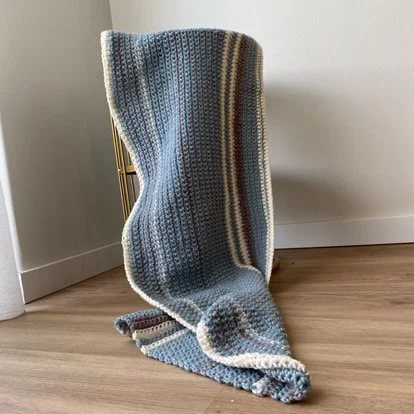Fashion, but make it sustainable
Marie Sztana, a sustainable fashion advocate, with her crochet temperature blanket.
What is it like when you study your dream subject – fashion design – only to discover two years in that you are working towards joining one of the most polluting industries? This is what happened to Marie Sztana, whose degree taught her how to construct clothes but didn’t really address the elephant in the room: the fashion industry’s devastating environmental impact. This experience drove her to learn all she could about sustainability. Since graduating, she has worked at a sustainable fashion label in Lisbon, and nowadays hosts the 2g1reusablecup and creates viral content on social media about climate change.
What is sustainable fashion?
According to Earth Day: “Sustainable fashion refers to a clothing supply chain that is ecologically and socially responsible. It aims to reorient the industry and consumers away from the fast fashion model and toward sustainable practices in sourcing, production, distribution, marketing, and consumption.”
Hence, sustainable fashion is the opposite of fast fashion (think Primark, H&M, Zara, etc) and Marie Sztana goes on: “There are two main aspects we should consider: environment-friendly materials and ethical production.”
Generally, biodegradable and natural materials are better for the environment than polyester, which is a plastic made from oil. However, considerations like durability and washability, for example, can make polyester necessary at times, as every sock knitter will be aware.
Talking about production, Marie underlines that the majority of clothes is still made in sweat shops and that we (especially in the Global North) have adopted an “out of sight, out of mind-mentality”. Ethical production pays the workers fair wages and ensures adequate safety measures in the factories.
Greenwashing, i.e. “when companies make themselves look eco-friendly to the public but continue polluting the environment behind the scenes” (Greenpeace) continues to mislead us as consumers. For Marie, this is directly linked to the lack of a clear definition for sustainable fashion: “Falling for greenwashing is so easy, but my number one advice is to identify a company’s output. If they keep putting out crap in obscene amounts, it is simply detrimental to the planet. There are enough clothes in the world!”
A 100% biodegradable and zero-waste final collection
Marie wanted to become a fashion designer, ever since she had watched The Devil Wears Prada: “Not the most original as I discovered later” she admits but it did not diminish her passion. However, discovering that the fashion industry is one of the biggest polluters, it rocked her world. She was especially shocked that this had never been brought up in classes.
As part of her degree from Lincoln University (2017-2019), Marie designed a final collection of four looks and she set out to make it sustainable: “I ended up making a dress, t-shirt, trousers, skirt and crop top from only 5 meters of hemp fabric. I used zero-waste cutting methods and naturally dyed pieces of the cream-coloured fabric with turmeric (yellow) and wood chips (purple), since I love complementary colours.” She even refused to use the standard polyester thread and searched for cotton alternatives and applied wooden buttons instead of zippers: “It ended up being the cheapest collection of my class at around 200 Euro.”
Nowadays, Marie admits that she barely touches her sewing machine, but rather knits and crochets. For her, fashion school did not only teach her how to design garments; it also gave her an increased sense of criticalness which she has internalised: “There was one teacher who would only allow patterns to be drawn up in a 2H pencil and judged my handwriting so much that I would print out my labels instead of handwriting them.”
“I’ve never done a swatch.”
She is a self-taught knitter and crocheter and I gasped when she told me “I’ve never done a swatch”. Contrary to her sewing practice, she gives herself a lot more grace here: “I am currently crocheting a temperature blanket and can’t seem to get the tension right. But it is not the end of the world if it is off; the blanket will still keep you warm.”
Marie’s temperature blanket is growing.
Each colour represents the temperature of the day.
Perfection is overrated
Marie is full of ideas, impatient to see them come to life, and cares less about achieving the perfect tension or sewing a perfectly straight line. As one of her lecturers once told her: “Marie, you have great ideas, but terrible execution”, which she is convinced will be the title of her biography.
And it strikes me how similar this approach is to sustainability: You don’t need to live a perfectly sustainable life to make an impact. Every bit will help, and here are Marie’s tips for conscious fashion consumers!
Top tips for more fashion sustainability
Learn how to care for your clothes
Think before you buy (“The most sustainable piece is the one already in your wardrobe.”)
Shop at charity shops or second-hand places like Vinted
Borrow from a friend or rent
Buy new from sustainable brands
If buying fast fashion, consider longevity of the piece (“What sacrifices were made, so that you can pay only 5 Euro?”)







